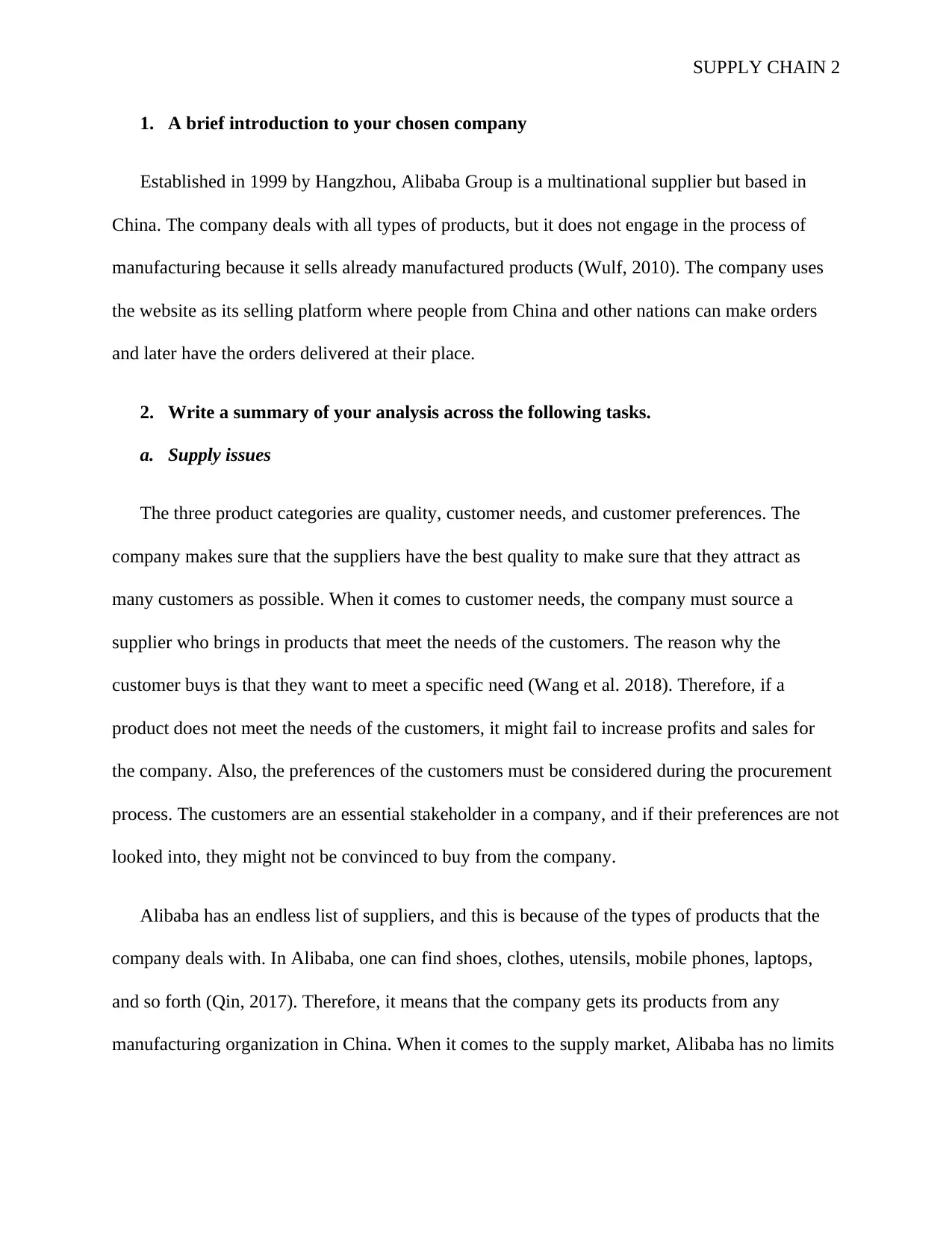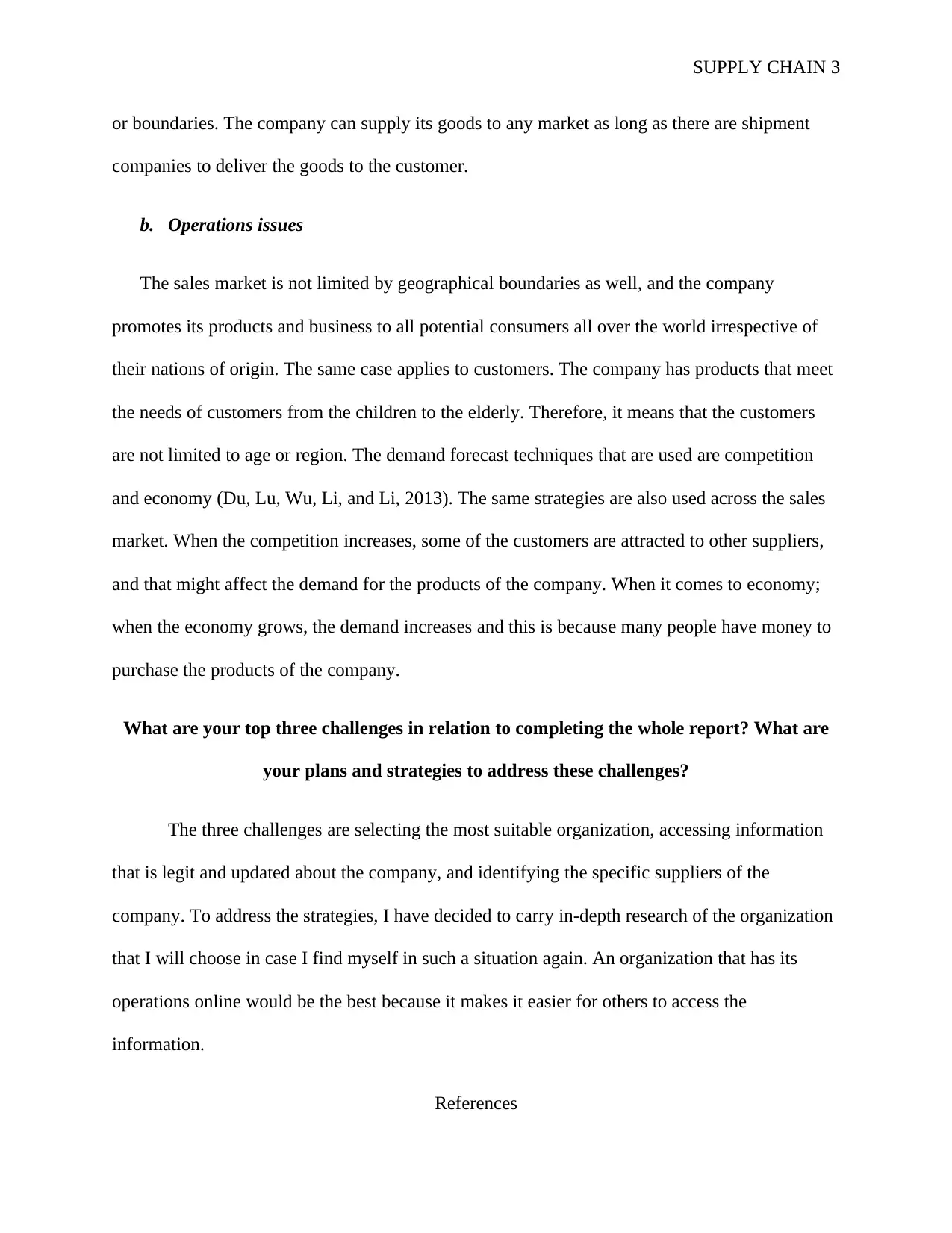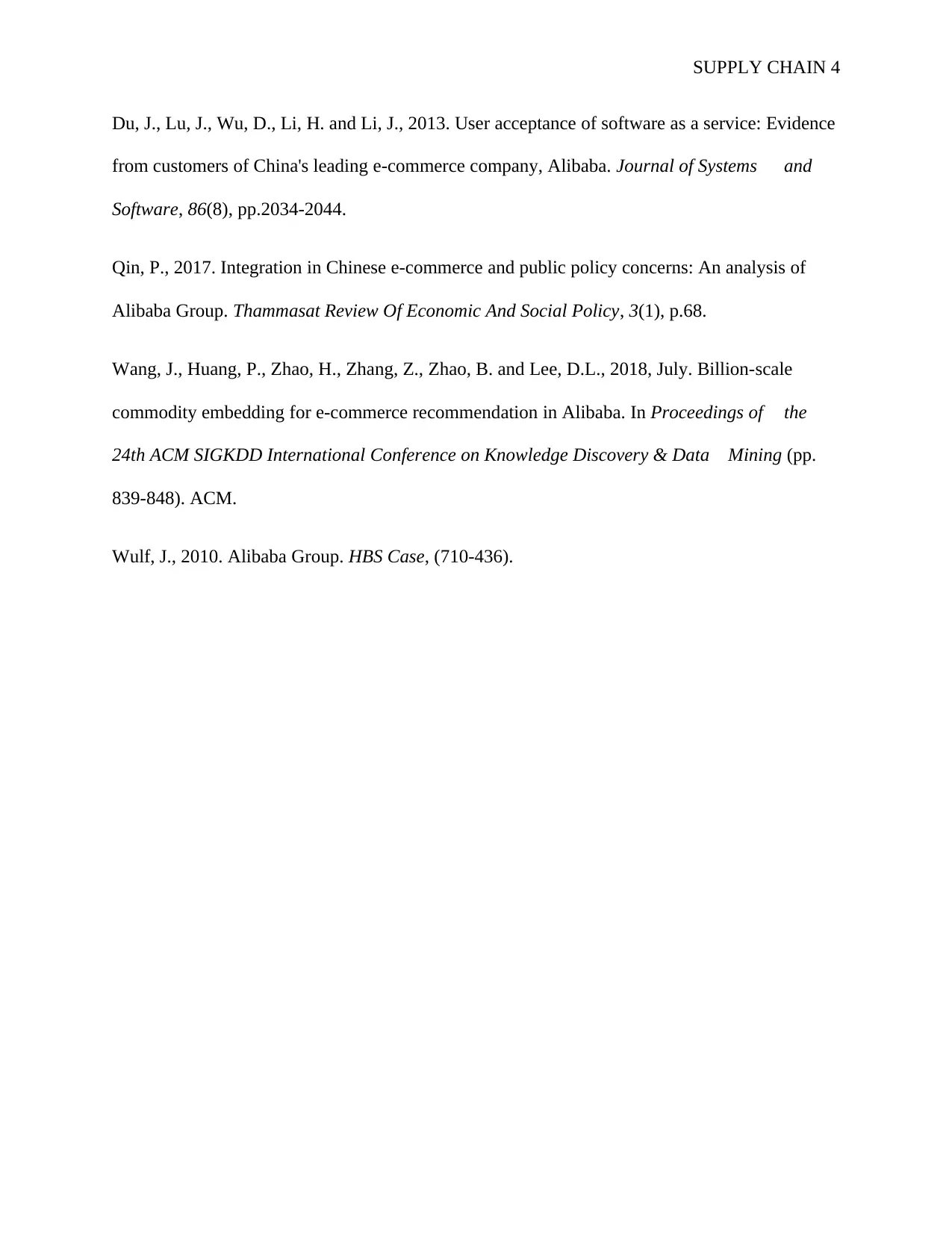Alibaba Group's Supply Chain: An In-Depth Analysis Report
VerifiedAdded on 2023/01/18
|4
|838
|65
Report
AI Summary
This report provides an analysis of Alibaba Group's supply chain, focusing on sourcing, operations, and challenges. It highlights the company's approach to ensuring quality, meeting customer needs and preferences in its procurement process. Alibaba's extensive supplier network, driven by its diverse product range, and its global sales market are discussed. The report identifies key demand forecasting techniques like competition and economic factors. It also addresses challenges encountered during the report's completion, such as selecting a suitable organization, accessing updated information, and identifying specific suppliers, along with strategies to overcome these hurdles. Desklib provides access to this and many other solved assignments for students.

SUPPLY CHAIN 1
SUPPLY CHAIN
Student’s Name
Professor’s Name
Institution
Course
Date
SUPPLY CHAIN
Student’s Name
Professor’s Name
Institution
Course
Date
Paraphrase This Document
Need a fresh take? Get an instant paraphrase of this document with our AI Paraphraser

SUPPLY CHAIN 2
1. A brief introduction to your chosen company
Established in 1999 by Hangzhou, Alibaba Group is a multinational supplier but based in
China. The company deals with all types of products, but it does not engage in the process of
manufacturing because it sells already manufactured products (Wulf, 2010). The company uses
the website as its selling platform where people from China and other nations can make orders
and later have the orders delivered at their place.
2. Write a summary of your analysis across the following tasks.
a. Supply issues
The three product categories are quality, customer needs, and customer preferences. The
company makes sure that the suppliers have the best quality to make sure that they attract as
many customers as possible. When it comes to customer needs, the company must source a
supplier who brings in products that meet the needs of the customers. The reason why the
customer buys is that they want to meet a specific need (Wang et al. 2018). Therefore, if a
product does not meet the needs of the customers, it might fail to increase profits and sales for
the company. Also, the preferences of the customers must be considered during the procurement
process. The customers are an essential stakeholder in a company, and if their preferences are not
looked into, they might not be convinced to buy from the company.
Alibaba has an endless list of suppliers, and this is because of the types of products that the
company deals with. In Alibaba, one can find shoes, clothes, utensils, mobile phones, laptops,
and so forth (Qin, 2017). Therefore, it means that the company gets its products from any
manufacturing organization in China. When it comes to the supply market, Alibaba has no limits
1. A brief introduction to your chosen company
Established in 1999 by Hangzhou, Alibaba Group is a multinational supplier but based in
China. The company deals with all types of products, but it does not engage in the process of
manufacturing because it sells already manufactured products (Wulf, 2010). The company uses
the website as its selling platform where people from China and other nations can make orders
and later have the orders delivered at their place.
2. Write a summary of your analysis across the following tasks.
a. Supply issues
The three product categories are quality, customer needs, and customer preferences. The
company makes sure that the suppliers have the best quality to make sure that they attract as
many customers as possible. When it comes to customer needs, the company must source a
supplier who brings in products that meet the needs of the customers. The reason why the
customer buys is that they want to meet a specific need (Wang et al. 2018). Therefore, if a
product does not meet the needs of the customers, it might fail to increase profits and sales for
the company. Also, the preferences of the customers must be considered during the procurement
process. The customers are an essential stakeholder in a company, and if their preferences are not
looked into, they might not be convinced to buy from the company.
Alibaba has an endless list of suppliers, and this is because of the types of products that the
company deals with. In Alibaba, one can find shoes, clothes, utensils, mobile phones, laptops,
and so forth (Qin, 2017). Therefore, it means that the company gets its products from any
manufacturing organization in China. When it comes to the supply market, Alibaba has no limits

SUPPLY CHAIN 3
or boundaries. The company can supply its goods to any market as long as there are shipment
companies to deliver the goods to the customer.
b. Operations issues
The sales market is not limited by geographical boundaries as well, and the company
promotes its products and business to all potential consumers all over the world irrespective of
their nations of origin. The same case applies to customers. The company has products that meet
the needs of customers from the children to the elderly. Therefore, it means that the customers
are not limited to age or region. The demand forecast techniques that are used are competition
and economy (Du, Lu, Wu, Li, and Li, 2013). The same strategies are also used across the sales
market. When the competition increases, some of the customers are attracted to other suppliers,
and that might affect the demand for the products of the company. When it comes to economy;
when the economy grows, the demand increases and this is because many people have money to
purchase the products of the company.
What are your top three challenges in relation to completing the whole report? What are
your plans and strategies to address these challenges?
The three challenges are selecting the most suitable organization, accessing information
that is legit and updated about the company, and identifying the specific suppliers of the
company. To address the strategies, I have decided to carry in-depth research of the organization
that I will choose in case I find myself in such a situation again. An organization that has its
operations online would be the best because it makes it easier for others to access the
information.
References
or boundaries. The company can supply its goods to any market as long as there are shipment
companies to deliver the goods to the customer.
b. Operations issues
The sales market is not limited by geographical boundaries as well, and the company
promotes its products and business to all potential consumers all over the world irrespective of
their nations of origin. The same case applies to customers. The company has products that meet
the needs of customers from the children to the elderly. Therefore, it means that the customers
are not limited to age or region. The demand forecast techniques that are used are competition
and economy (Du, Lu, Wu, Li, and Li, 2013). The same strategies are also used across the sales
market. When the competition increases, some of the customers are attracted to other suppliers,
and that might affect the demand for the products of the company. When it comes to economy;
when the economy grows, the demand increases and this is because many people have money to
purchase the products of the company.
What are your top three challenges in relation to completing the whole report? What are
your plans and strategies to address these challenges?
The three challenges are selecting the most suitable organization, accessing information
that is legit and updated about the company, and identifying the specific suppliers of the
company. To address the strategies, I have decided to carry in-depth research of the organization
that I will choose in case I find myself in such a situation again. An organization that has its
operations online would be the best because it makes it easier for others to access the
information.
References
⊘ This is a preview!⊘
Do you want full access?
Subscribe today to unlock all pages.

Trusted by 1+ million students worldwide

SUPPLY CHAIN 4
Du, J., Lu, J., Wu, D., Li, H. and Li, J., 2013. User acceptance of software as a service: Evidence
from customers of China's leading e-commerce company, Alibaba. Journal of Systems and
Software, 86(8), pp.2034-2044.
Qin, P., 2017. Integration in Chinese e-commerce and public policy concerns: An analysis of
Alibaba Group. Thammasat Review Of Economic And Social Policy, 3(1), p.68.
Wang, J., Huang, P., Zhao, H., Zhang, Z., Zhao, B. and Lee, D.L., 2018, July. Billion-scale
commodity embedding for e-commerce recommendation in Alibaba. In Proceedings of the
24th ACM SIGKDD International Conference on Knowledge Discovery & Data Mining (pp.
839-848). ACM.
Wulf, J., 2010. Alibaba Group. HBS Case, (710-436).
Du, J., Lu, J., Wu, D., Li, H. and Li, J., 2013. User acceptance of software as a service: Evidence
from customers of China's leading e-commerce company, Alibaba. Journal of Systems and
Software, 86(8), pp.2034-2044.
Qin, P., 2017. Integration in Chinese e-commerce and public policy concerns: An analysis of
Alibaba Group. Thammasat Review Of Economic And Social Policy, 3(1), p.68.
Wang, J., Huang, P., Zhao, H., Zhang, Z., Zhao, B. and Lee, D.L., 2018, July. Billion-scale
commodity embedding for e-commerce recommendation in Alibaba. In Proceedings of the
24th ACM SIGKDD International Conference on Knowledge Discovery & Data Mining (pp.
839-848). ACM.
Wulf, J., 2010. Alibaba Group. HBS Case, (710-436).
1 out of 4
Related Documents
Your All-in-One AI-Powered Toolkit for Academic Success.
+13062052269
info@desklib.com
Available 24*7 on WhatsApp / Email
![[object Object]](/_next/static/media/star-bottom.7253800d.svg)
Unlock your academic potential
Copyright © 2020–2025 A2Z Services. All Rights Reserved. Developed and managed by ZUCOL.




